by Jack Radley // Mar. 2, 2021
Basquiat is not the only eminent artist in Brooklyn’s Green-Wood Cemetery. Heidi Lau recently took the reigns as the cemetery’s first-ever artist in residence, occupying an historic studio in the Fort Hamilton Gatehouse. The space boasts stained glass windows, kiln access, and an attic that is as spooky as it is ripe for displaying her work, which deals with death, memory and decay. Lau, who recently represented Macau in the 58th Venice Biennale, unearths and reconstructs histories through invented, zoomorphic artifacts and ruins. Her work extracts histories from Daoist folklore, colonial interventions and Eastern mythologies to transform them into ceramic forms that underscore the transient nature of home.
Green-Wood is an apt place for Lau to shape her next body of work. She reincarnates old pieces into new forms in her evolving practice. On occasion, Lau embeds ashes from the firing process into the works themselves, ingrained with markers of their making and mortality. On a frigid January afternoon, I visited Lau in her newly minted studio, where we discussed her work’s relationships to death and ritual, the intersection of monstrosity and identity, and her plans for a year at Green-Wood.
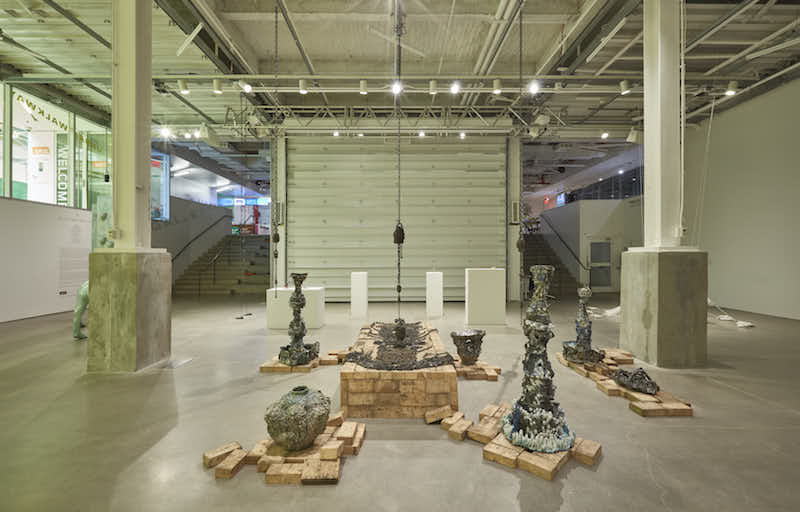
Heidi Lau: ‘Death Becomes Her,’ 2020, installation view at BRIC // Courtesy of BRIC, Photo by Jason Wyche
Jack Radley: Can you tell me a little bit about how you came to be in residence at Green-Wood, and how it’s been so far?
Heidi Lau: This is a perfect and strange place for a residency. I actually worked with Harry Weil, Director of Public Programs and Special Projects at the Cemetery, on an exhibition last year at BRIC called ‘Death Becomes Her.’ I was walking around the cemetery, hoping to find some stones to use as a pedestal, as an installation element for my work. They have an operating crematorium. These days, many people are talking about working from home. For the people who work here, no one works for home.
JR: Yeah, you can’t do that at your kitchen table.
HL: Six months into the pandemic, I saw a call for artists-in-residence. I can’t do a lot of residency programs in NYC because I need a kiln. They have a stone workshop to fix up the tombstones here, so having a kiln isn’t a big deal for them, which is why I decided to apply.
JR: Do you find yourself spending time outside of the studio walking the grounds?
HL: Yeah, it’s been very cold, but yes. Part of the reason why I applied was that I was really interested in all the epitaphs of the tombstones, because I feel like they are all little pieces of sculpture in their own way. Some of them are very wild.
I’ve been coming to the cemetery as long as I’ve lived in New York, but I’ve never seen so many fresh flowers as right now for people who were recently buried. There are a lot of families around attending to these graves—during COVID, this is more real than any other time I’ve been here.
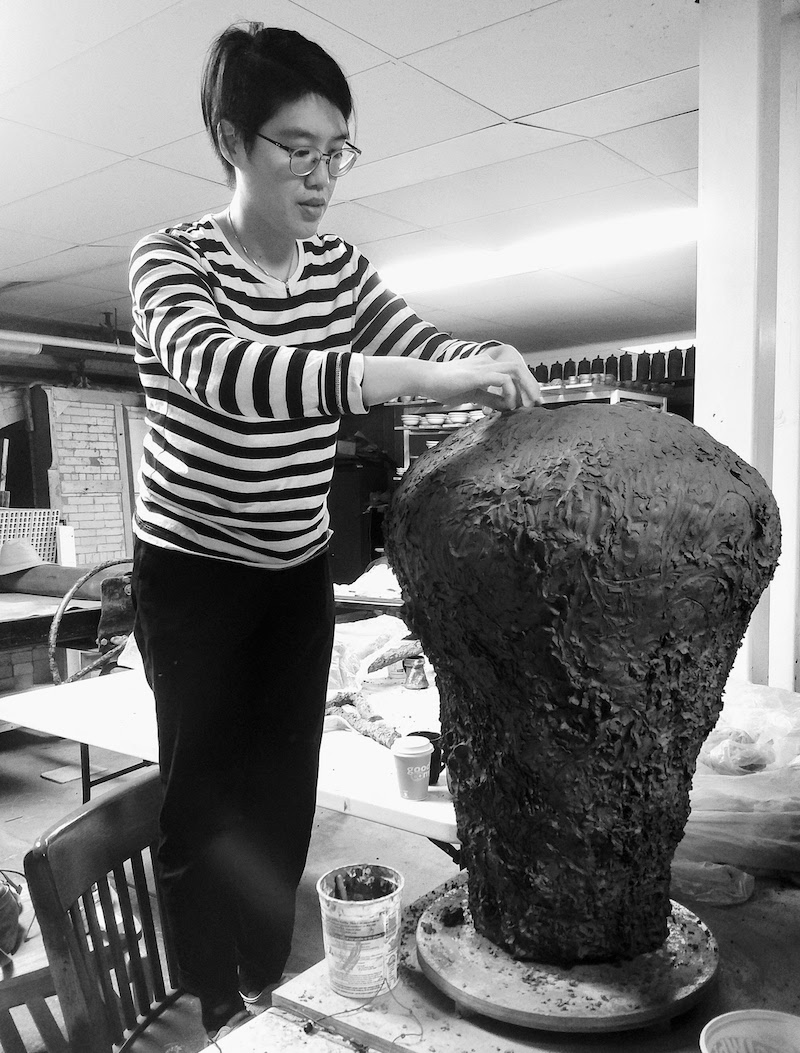
Heidi Lau, artist portrait // Courtesy of the artist
JR: What are you excited to work on?
HL: In terms of new work, I’m still in a sketching phase, but I think for my final project I want to do an outdoor installation in the Tranquility Garden, an area where they keep urns: directly on the water, I think. I’ve been thinking of taking some of these pieces apart to form vessels or urn-shaped structures.
JR: It’s common for you to rework pieces, right?
HL: I think it started as a need. My first kiln was tiny, so I always make things in sections. But even now that my kiln is bigger, I still find myself making pieces and then taking them apart. And then adding to them.
JR: Even in a cemetery, your pieces never die—they have multiple lives.
HL: I feel like people think that with ceramics, there’s a sense of finality. As if, once you fire it, you’ll never turn back to clay. But I feel like it’s still possible to mess with the timeline a little bit.
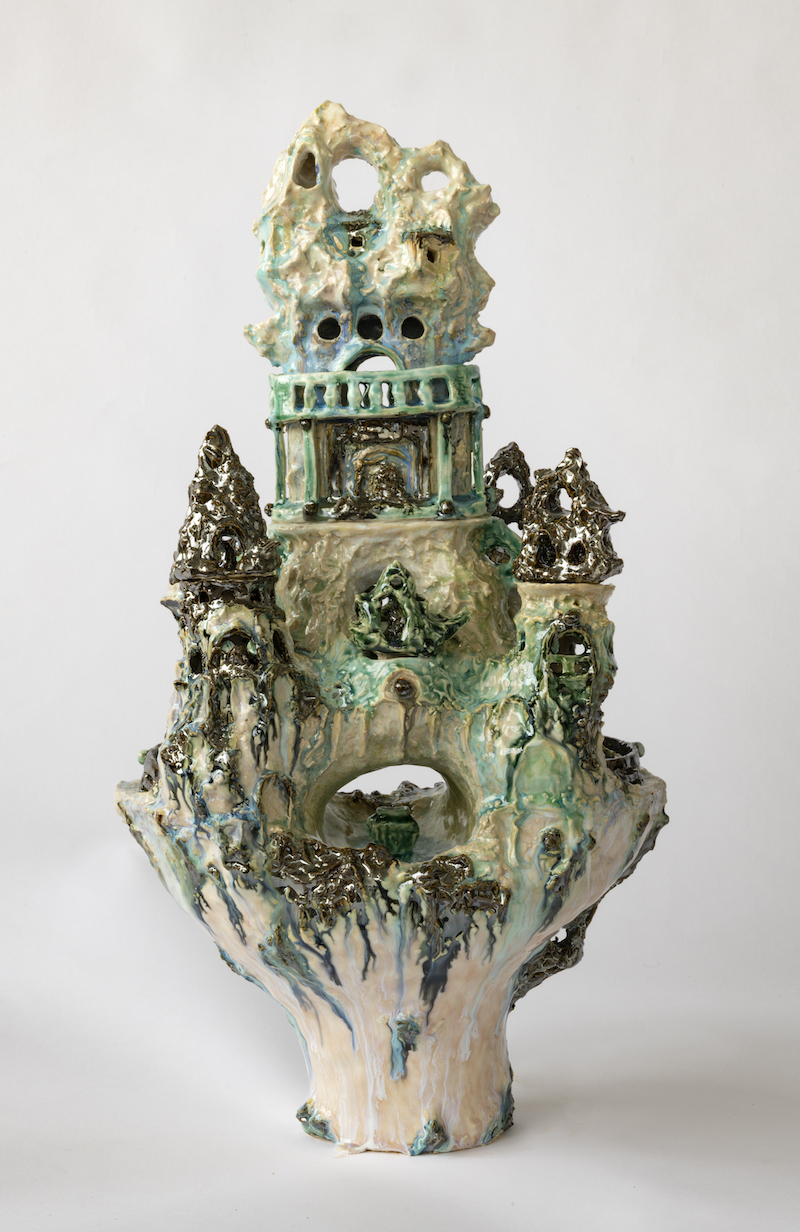
Heidi Lau: ‘Mercury Six-spouted Vessel,’ 2020, ceramic with crystalline glaze. 25 1/2 x 8 1/2 x 13 1/2 in. // Courtesy of the artist and Matthew Brown Los Angeles, Photo by Adam Reich
JR: Do you start every piece with a sketch?
HL: I usually don’t, but for things outdoors it’s better to have an actual plan and work backwards based on the limitations of the space. The team here was telling me that cremation was very un-Catholic back in the day. They built that area very specifically, having Asian American communities in mind. I feel like it would be really meaningful for me to make work for diasporic ashes.
I find myself thinking, what would I do with my own body? I feel like I emotionally have such a tie to Macau, where I grew up, and being able to “return home” has such a cultural significance to a lot of Chinese and Asian communities. But for many, the Tranquility Garden is their permanent resting place now. To be able to make work that gets to be around them—I don’t take that lightly.
JR: What was your relationship to death like growing up in Macau?
HL: My grandparents are super Daoist, and I actually flew back to Macau for both of their funerals. Daoist funerals are very genealogical, everybody has a part in what feels like a big three-day performance. The eldest son performs certain things like cleaning the body; being the youngest granddaughter, I’m basically useless. [laughs] During these three-days, there’s a lot of incense burning, folding paper money, and everybody eats vegetarian in the same room, next to the body. You really are honoring them in this final ritual.
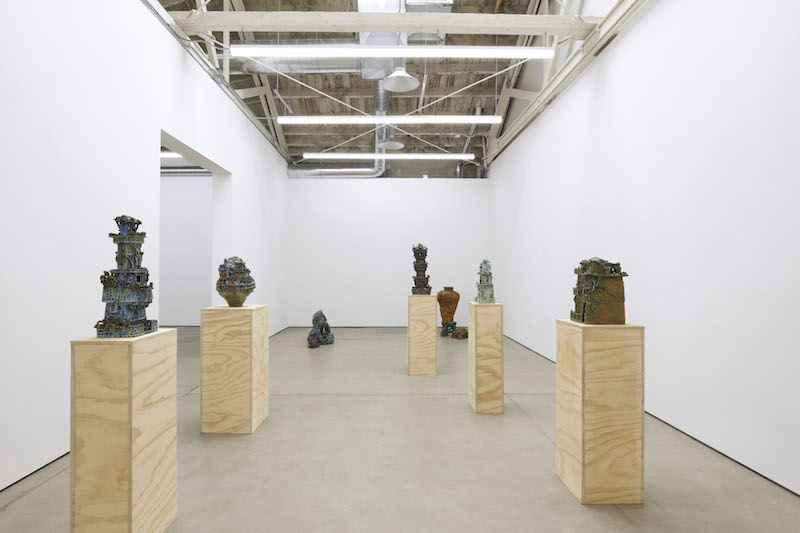
Heidi Lau: ‘Spirit Vessels,’ 2020, installation view at Matthew Brown Los Angeles // Courtesy of the artist and Matthew Brown Los Angeles
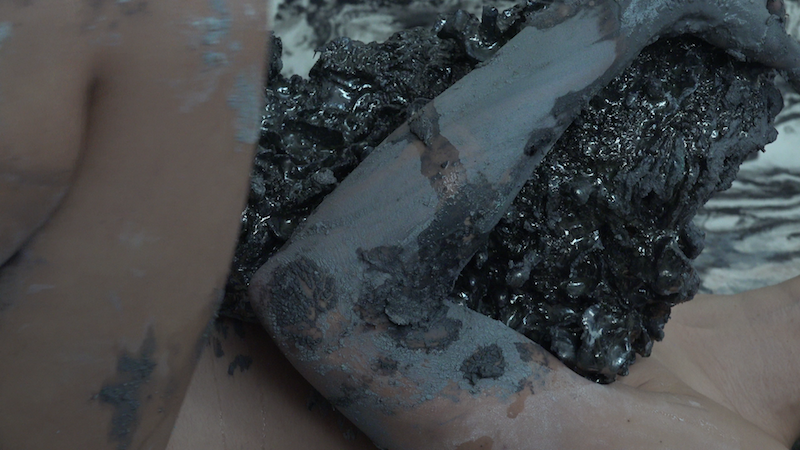
Heidi Lau and Future Host: ‘Worlding Hands,’ 2020, Still from single-channel Video // Courtesy of the artist and Future Host (Tingying Ma and Kang Kang)
JR: Have you made work that’s more performative in nature?
HL: I recently started working with my two friends Tingying Ma and Kang Kang, who have a collaboration called Future Host. We performed a work called ‘Worlding Hands’ that references this book called ‘Shanhaijing’ (The Books of Mountains and Seas). It’s kind of like an ancient Daoist encyclopedia of mythical creatures and cosmology, but honestly it’s the most transgressive and queer text ever. Some of these androgynous creatures cross-pollinate and have to assassinate each other to survive. It’s very primal.
For the performance, we mostly referenced the snake goddess, Nuwa. She supposedly used clay to create a world, and then she slayed this giant turtle and used its legs as columns to support the sky from falling. The performance consists of a series of somatic trainings and movements to agitate the body. We want to envision a future that foregrounds the corporeal experience, evoking the skeletal, muscular and sonorous memories in the performer and cultivating the body’s return to the primordial state.
Working on this performance, we were thinking a lot about what a pre-colonial world looks like. Future Host and I are both Chinese diasporic; Macau became ‘Macau’ after it was colonized by Portugal. There was so little self-awareness; with its new name came our new identity and othering. How can we reincarnate ourselves into that space? Also, I feel like if I have to be othered, I would rather be an evil monster, and not this soft, mythical creature for people to feel good about themselves.
JR: I love the motif of hands throughout your work. Can you speak a little more about that?
HL: I feel like sometimes the works make themselves, and I’m just a medium for something. The hands are kind of the works creating themselves.
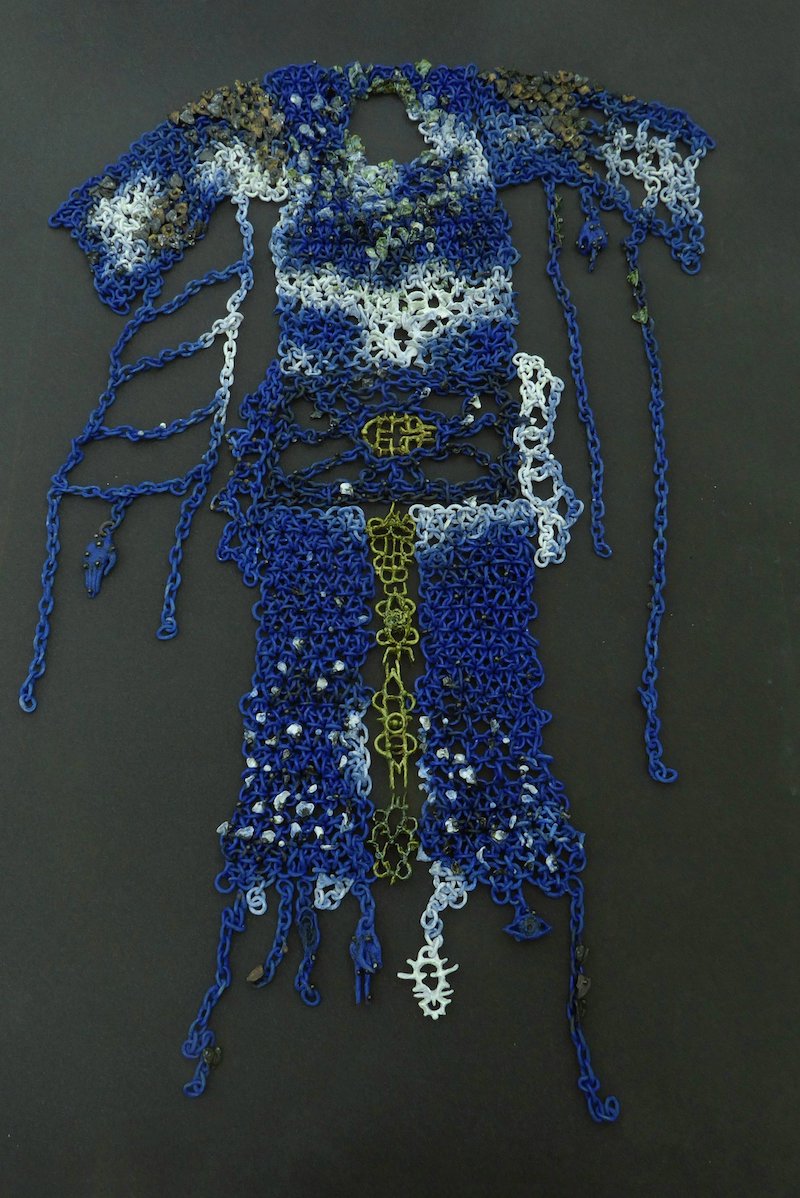
Heidi Lau: ‘The Blue Robe,’ 2018, Glazed Ceramics, 42” x 89” x 5” // Courtesy of the artist and Matthew Brown Los Angeles
JR: Let’s talk about one work, ‘The Blue Robe,’ which appears like a garment.
HL: This is the second garment that I’ve made, the first one I made shortly after my mom passed away. I feel like it’s partially about her, because that one had a lot of bone marrow ornaments. She died of leukemia. That was also the time when I was reading ‘Ornamentalism’ by Anne Anlin Cheng, which talks a lot about how Asian female bodies were represented and embodied through ornaments. I feel like the burial ground is the perfect area where human and object relationships become so slippery, they’re almost the same.
JR: And a garment is meant to be worn or inhabited.
HL: I feel the same way with vessels—every vessel is holding something, whether it’s more metaphysical, like energy, or a container of grief, like ashes.
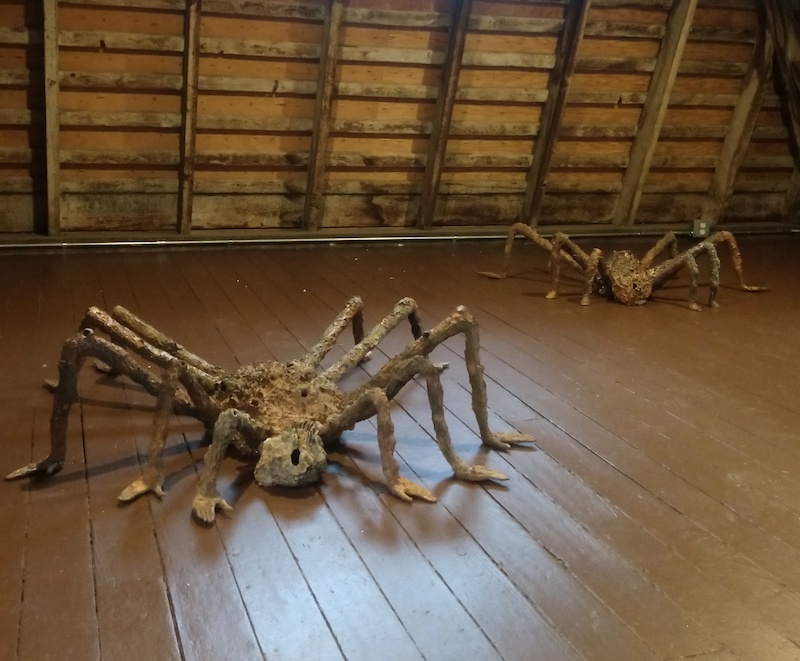
Heidi Lau: ‘Mother and Daughter,’ 2020, Installation View at Green Wood Cemetery, Glazed and Wood-fired Ceramics, 13” x 56” x 33”, 10.5”x 43” x 24” // Courtesy of the artist and Matthew Brown Los Angeles
JR: How did you arrive at the spider forms in ‘Mother and Daughter’?
HL: These are monstrous creatures that have their own subjectivity. I asked myself: what would this creature need? You know in ‘Shanhaijing,’ the book I mentioned, there’s this creature with an ear that could hear 1,000 miles away. That was really its only sense, it couldn’t speak or see. I like that these creatures could have their own way of understanding the world, that’s not for humans to even have access to.
This article is part of our feature topic of ‘Ritual.’ To read more from this topic, click here.
Artist Info
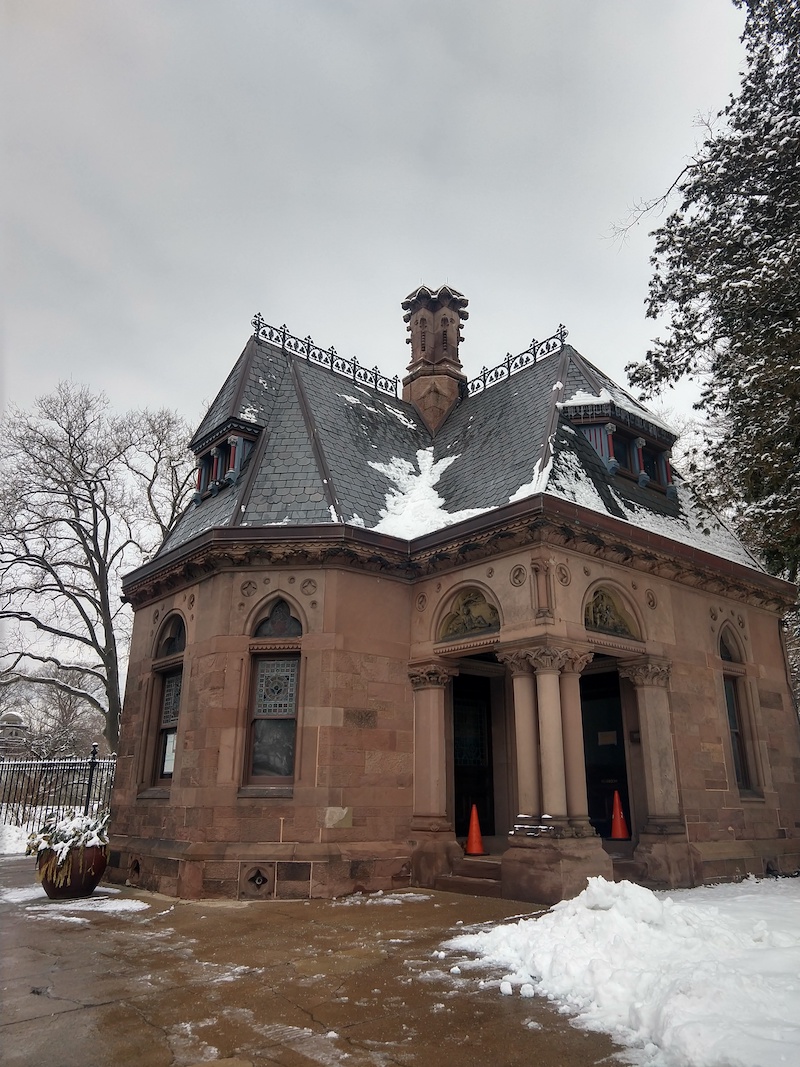
Green-Wood Cemetery studio // Courtesy of the artist


























